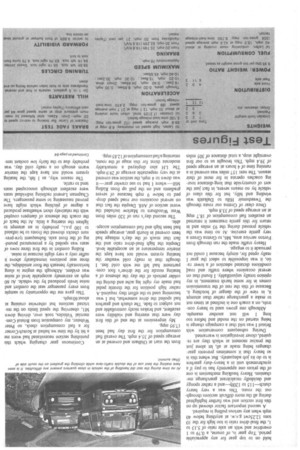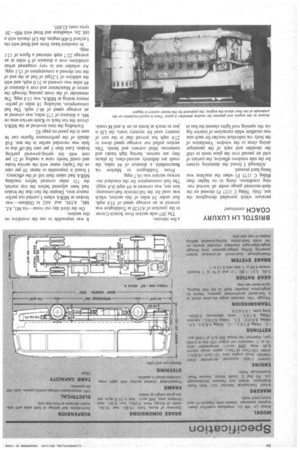Bristol LH/Plaxton 41-seat coach
Page 83

Page 84

Page 86

If you've noticed an error in this article please click here to report it so we can fix it.
WITH the introduction of the LH lightweight chassis Bristol Commercial Vehicles Ltd. entered a section of the passenger vehicle market which hitherto had been satisfied largely by the high-quantity producers. Bristol's market research showed that there was a need for a passenger chassis which fell between the weight and price extremes into which the p.s.v. market tended to be divided. Their answer, revealed in June 1967, was the LH underfloorengined range of vehicles.
The LH range is produced in three wheelbase lengths-12ft 6in., 16ft 2in. and 18ft 6in. It offers either of two engines popular in the passenger field, the Perkins 6.354 or the Leyland 0.400. The transmissions, by Turner/Clarke, too, were selected as being widely used in lightweight passenger chassis in order that there should be a ready acceptability by operators not wishing to increase their spare-parts holdings.
Although the LH was first introduced 19 months ago it was not until recently that a• bodied vehicle fitted with the Leyland engine was made available for road testing. The vehicle used was one that had seen a season's service with Byngs Coaches of Portsmouth and at the start of the test had 15,349 miles on its recorder. The vehicle was lent to us for the test by Lancashire Motor Traders Ltd. of Oldham, the parent company of Byngs Coaches.
It was fitted with a Plaxton Panorama 1 body and had a wheelbase of 16ft 2in. Equipped for luxury touring and excursion work, it had Chapman Leverot seats for 41 persons, and was laden to represent 41 passengers each with 28113 of luggage.
The test comprised a performance evaluation and an operational run over a distance of 869 miles. Throughout the test the vehicle behaved very well and no mechanical troubles were experienced. Fuel consumption proved to be both above and below average under extremes of conditions. Whereas a best figure of 18.7 mpg was recorded, the worst was 6.8 mpg.
General handling of the vehicle was extremely accurate if somewhat heavy on the driver. At no time during the operational run, which took in every sort of route, did I have any anxiety in keeping the machine under complete control. During the perfor mance testing the LH proved itself to be a bit of a wolf in sheep's clothing, in that it produced quite useful acceleration figures despite the fact that it had. given me the impression of being somewhat sluggish. Nevertheless, I finished the test with a distinct feeling that the machine was overgeared for most road conditions.
Because the garage where the vehicle was based was in Oldham, the usual CM opera tional trial circuit was started from there instead of London. Our route then followed that used on previous occasions, via M6,A6, A74, A701, A68, Al, MI and AS where we rejoined M6 and returned to Oldham. A de viation froth the usual route was made at the junction of A5120 /M1 Toddington to my home at Marlow, Bucks, and in fact this section took in some secondary roads which are a fair sample of the type, for instance, which might be found on a mystery tour.
Leaving the Oldham premises of LMT at 7.30 a.m. on a cold and foggy morning our route to M6 at Preston took us through Radcliffe and along the Bolton by-pass. During this section of the run where visibility was poor I found it impossible to
hold on to top gear for any appreciable period. Top gear is, of course, a 0.79 to 1 overdrive and with an axle ratio of 5.13 to 1,.the final-drive ratio is too high for the 10 tons 12.25cwt g.v.w. at anything below 40 mph when any serious pulling is required.
A second important factor showed up on this first section and was further highlighted during all the more difficult sections throughout the route. This was a very heavy clutch-115 to 1201b—and a rather spongy and decidedly recalcitrant gearchange mechanism. Heavy baulking mechanism is one of the prices one apparently has to pay if a synchromesh unit in a heavy-duty gearbox is to do its job adequately. But where this is so heavy that it sometimes prevents gearchanges being made at all, let alone just the precise moment at which they are required, closer investigation is warranted.
During subsequent conversation with Bristol I was told that a campaign change is being started on the model and before too long I will test another example.
Although one grows used to heavy controls, on a coach one is inclined at times not to make a gearchange rather than attempt it, in view of the danger of botching it. Because of this the rest of the transmission comes in for some harsh treatment, in my opinion totally unjustifiably. I found that on several occasions where traffic and road conditions dictated selection of a lower ratio, it was impossible to select the gear I really opted for, simply because I could not persuade it to engage.
• Heavy traffic made the run through from Porton service area, M6, to Gretna Green a very gentle exercise. At no time was the vehicle pressed during the 93 miles and in return for this gentle treatment it returned an excellent fuel consumption of 18.7 mpg at an average speed of 33.8 mph.
Once clear of Gretna our route through the Tweedsmuir Hills to Dalkeith was winding and hilly, but for this class of vehicle by no means severe, in fact just the sort of countryside that long-distance touring coaches operate in for most of their season. The next 157 miles was covered in a running time of 4 hours at an average speed of 39.4 mph. This brought us to our first overnight stop, a total distance of 305 miles from the start at Oldham and covered at an average speed of 35.4 mph. The overall fuel consumption for the first day had been 17.95 mpg.
My impressions at the end of this first day were that steering and visibility were excellent, and brakes nicely controllable and not subject to fade. The clutch and gearbox had spoiled the drive somewhat, but I was becoming used to the effort they required. A rather high position for the throttle pedal had made my right leg ache and during the colder periods of the day the absence of a heating nozzle for the driver's foot compartment had left me with cold feet. I thought that in really cold weather the heating system would not have kept the interior temperature at an acceptable level. Despite, the high final-drive ratio and the fact that much of the day's mileage had been covered in fourth gear, average speeds had been high and fuel consumption acceptable.
The second day's run of 320 miles from West Woodburn to Marlow included the worst section of A68. Despite the fact that on several .occasions our road speed dropped to below 9 mph because of severe gradients and on the pull up from Riding Mill—where I had to use crawler gear—it was down to 4 mph, the section was covered at the very respectable average of 29.9 mph. The LH also displayed a remarkably moderate thirst for this stage of the route, returning a fuel consumption of 12.85 mpg. Continuous gear changing which this punishing section necessitated had worn me a bit by the time we halted at Scotch Corner for a fuel consumption check, so Peter Webster, my companion from Bristol Commercial Vehicles, took over, driving down Ml, observing the speed limits on the restricted sections but otherwise cruising at about 60 mph.
This gave me the opportunity to sample from every passenger seat the comfort and noise levels produced by the vehicle. At 60 mph an extremely acceptable level of noise was evident. Although the engine is slung horizontally beneath the floor amidships, the three seat positions immediately above it suffer only a very slight increase in noise.
Riding comfort in the first three rows of seats was spoiled by a pronounced pounding of the front axle. Subsequent tyre-pressure checks showed the fronts to be inflated to 100 p.s.i., probably in an attempt to lighten the steering a little. At the back of the coach the absence of dampers coupled with the relatively short wheelbase produced a degree of pitching which might have proved nauseating to some passengers. The Chapman Leverol reclining individual seats were excellent although unoccupied seats tend to rattle.
The reason why, as I felt, the heating system would not have kept the interior warm enough on a really cold day, was probably due to the fairly low coolant tern perature which prevailed throughout the test. Only 70deg C (157 F) showed on the dash-mounted gauge under all normal running conditions, rising to no higher than 80deg C (175 F) when the machine was being hard pressed.
Although I found the demisting system for the side windows effective, the curtain of cold air passed over the glass tends to chill the shoulder and neck of the passenger sitting close to the window. Ventilation of. the body via individual nozzles for each seat was excellent while extraction of interior fug via the opening roof lights cleared the bus in a few minutes.
The 207-mile section from Scotch Corner to the junction of A5120 at Toddington was covered at an average speed of 55.6 mph. Just under 24 miles of this section, which was used for the full-throttle fuel-consumption test, was covered at 69 mph (6.8 mpg). The fuel consumption for the standard motorway section was 16.7 mpg.
From Toddington to Marlow via Beaconsfield, a distance of 44 miles, the roads are definitely second-class. In places they are narrow, having high banks and numerous blind corners and bends. This section pulled our average speed down to 27.6 mph but proved that in the sort of country used for mystery tours, the LH is just as much at home as on A and M roads.
It was impossible to use the overdrive on this section.
On the third day our route—via Ml, A5, M6, A556, and A62 to Oldham—was
broken at.MIRA where I carried out performance tests. Despite the fact that the brakes
had been adjusted before the trip started, the 731 miles covered before reaching MIRA had taken their toll of the efficiency.
I found it impossible to better 50 pet cent on the Tapley meter with the service brake and could barely raise a reading of 21 per cent with the spring-powered parking brakes. Less than 5 per cent fall-off due to fade was recorded earlier in the test. Full details of the performance figures can be seen in the panel on page 82.
Excluding the time involved at the MIRA circuit the run back to Keele service area on M6, a distance of 175 miles, was covered at an average speed of 46.1 mph. The fuel consumption, including 18 miles of perfor mance testing at MIRA, was 13.4 mpg. The remainder of the route passing through the centre of Manchester and over a distance of 49 miles was covered at 31.0 mph, and with the addition of 3.25 gal of fuel at the end of the run showed.a consumption of 15.1 mpg.
An unladen test in very congested urban conditions over a distance of 9 miles at an average 22.7 mph returned a figure of 12.1 mpg.
In standard basic form and fitted with the Leyland 0.400 engine, the LH chassis with a 16ft 2in. wheelbase and fitted with 900-20 tyres costs £2,605.




























































































































































